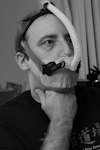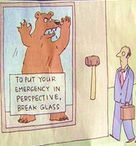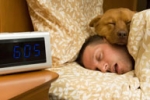Sleeping on back
Sleeping on back
This might be a stupid question, and I have searched for an answer, but I get conflicting answers. I know it's bad to sleep on your back with sleep apnea because it makes it worse. I've heard people say to sew tennis balls in their sleep shirts and stuff pillows under them so they don't lay on their backs.. But my question is can you sleep on your back safely while using CPAP? Or should back sleeping always be avoided? I ask because I am a side sleeper but the pillow tends to make my mask leak, so I wanted to try sleeping on my back or more on my back than side.
_________________
| Machine: AirCurve™ 10 VAuto BiLevel Machine with HumidAir™ Heated Humidifier |
| Mask: ResMed AirFit™ F20 Full Face CPAP Mask with Headgear |
Java 
Fifty Shades of Exhausted!
Fifty Shades of Exhausted!
Re: Sleeping on back
When you had your sleep study, did they have you sleep on your back for some of it? If your pressure was determined for sleeping on your back too, you're probably fine sleeping on your back. In my sleep study, I told them that I never sleep on my back, so they didn't test me sleeping that way, and I shouldn't do it. If in doubt, I'd ask your sleep doctor. Many people on CPAP sleep on their backs. As long as the pressure is enough to keep open the airways, it's fine.
Have you tried mask liners? I was amazed at how well they stop leaks. And, of course there are the CPAP pillows.
Have you tried mask liners? I was amazed at how well they stop leaks. And, of course there are the CPAP pillows.
_________________
| Mask: AirFit™ N30i Nasal CPAP Mask with Headgear Starter Pack |
| Humidifier: S9™ Series H5i™ Heated Humidifier with Climate Control |
| Additional Comments: MyAir app |
- zoocrewphoto
- Posts: 3732
- Joined: Mon Apr 30, 2012 10:34 pm
- Location: Seatac, WA
Re: Sleeping on back
What machine do you have? What is your pressure setting? I have an auto machine that is set from 11 - 17. This means that when I am on my side, it is usually in the 11-13 range, but it can go up as needed, which is usually when i am on my back. My machine has gone up into the 16s many times, but has only hit 17 8 times in over 3 months. My ahi is usually below 2, and often below 1. Very rarely over 5. So, even when I sleep on my back, it is able to prevent most apneas and keep my breathing correctly.
_________________
| Mask: Quattro™ FX Full Face CPAP Mask with Headgear |
| Humidifier: S9™ Series H5i™ Heated Humidifier with Climate Control |
| Additional Comments: Resmed S9 autoset pressure range 11-17 |
Who would have thought it would be this challenging to sleep and breathe at the same time?
Re: Sleeping on back
Often, being on your back needs higher pressure to keep obstructive sleep apneas & hypopneas. If you can handle those pressures okay, there's no problem sleeping on your back as far as CPAP goes.
_________________
| Mask: Swift™ LT Nasal Pillow CPAP Mask with Headgear |
| Humidifier: S9™ Series H5i™ Heated Humidifier with Climate Control |
| Additional Comments: Actually a S9 VPAP Adapt, and Respironics M Series Auto BiPAP |
Re: Sleeping on back
Java had an at-home sleep test and probably doesn't have information about how or if sleep position affects her apnea -- another limitation of these in-home devices. I have Kaiser as well and still don't know whether my apnea is worse on my back. In my case, though, I always sleep on my back so I know I was titrated for back sleeping. Java, did you sleep only on your side when you did your initial test? I can't remember if you've already done the week-long home titration, if so did you only sleep on your side?
The reason you get conflicting answers is probably because some people have positional apnea and for others position makes no difference. When you get your "mystery" machine let us know -- if it's a machine with full efficacy data you'll be able to start monitoring your therapy and your AHI. You can then experiment with your sleep position and see if there's a difference in your AHI with different sleep positions. If there is a difference then you may be able to adjust your pressure accordingly as need be.
If they send you a machine that only shows hours of use, I hope you'll be able to refuse it and instead get your doc to rewrite the Rx for a machine that gives you data about your sleep that you can view with free software on your computer.
The reason you get conflicting answers is probably because some people have positional apnea and for others position makes no difference. When you get your "mystery" machine let us know -- if it's a machine with full efficacy data you'll be able to start monitoring your therapy and your AHI. You can then experiment with your sleep position and see if there's a difference in your AHI with different sleep positions. If there is a difference then you may be able to adjust your pressure accordingly as need be.
If they send you a machine that only shows hours of use, I hope you'll be able to refuse it and instead get your doc to rewrite the Rx for a machine that gives you data about your sleep that you can view with free software on your computer.
_________________
| Machine: AirSense 10 AutoSet with Heated Humidifer + Aifit N30i Nasal Mask Bundle |
| Mask: Aloha Nasal Pillow CPAP Mask with Headgear |
| Additional Comments: SleepyHead-now-OSCAR software on Mac OSX Ventura |
Re: Sleeping on back
Correct, I had the at home sleep test and I already did the titration... all on my side. I guess I will wait and see what machine I get and hopefully I can experiment with different sleep positions. I will let you all know what machine I get (Should be Monday or Tuesday). Until then, thank you all for your help!kaiasgram wrote:Java had an at-home sleep test and probably doesn't have information about how or if sleep position affects her apnea -- another limitation of these in-home devices. I have Kaiser as well and still don't know whether my apnea is worse on my back. In my case, though, I always sleep on my back so I know I was titrated for back sleeping. Java, did you sleep only on your side when you did your initial test? I can't remember if you've already done the week-long home titration, if so did you only sleep on your side?
_________________
| Machine: AirCurve™ 10 VAuto BiLevel Machine with HumidAir™ Heated Humidifier |
| Mask: ResMed AirFit™ F20 Full Face CPAP Mask with Headgear |
Java 
Fifty Shades of Exhausted!
Fifty Shades of Exhausted!
Re: Sleeping on back
The number one goal is get the sleep. Get it in whatever position promotes good hours of sleep.
While it is true that supine sleeping can promote more events or the need for more pressure...it is not an automatic given.
Not everyone will need more pressure on their back and not everyone will have more events pop up.
I happen to have more events and need more pressure during REM sleep. I sure can't, nor do I want to, avoid REM sleep.
We need the normal cycles of sleep for the sleep to do its restorative magic.
Now there are a few people where the pressure needs when supine sleeping is markedly increased. Rooster found out he needed like 18 cm on his back and 9 cm on his side. That is a huge difference and don't blame him at all for wanting to stay on his side. Those people can make a decision to either use higher pressures all the time or maybe use APAP machine or try to learn to stay on their side.
Not everyone can sleep well on their side for any number of reasons. If we can't sleep on our sides...then we sleep on our backs and let the machine do the job it is designed to do. It's not like we have totally positional OSA where we have zero events on our sides anyway and wouldn't be using the machine on our side.
This is a situation where it might be beneficial for a person to have APAP machine and use the auto adjusting pressures...just in case.. and sleep in whatever position a person sleeps the best.
For sure need to have a full data machine so the effects of supine sleeping can be monitored. Then the options can be better evaluated.
Again, not everyone has "worse" OSA on their back (some do and some don't) and not everyone will need markedly higher pressures with supine sleeping. Though even if they did...there are options and things to do to make it work.
To me it makes zero sense to try to force a sleeping position at the expense of sleep. Let the machine do its job and sleep in whatever position promotes good hours and good quality sleep.
While it is true that supine sleeping can promote more events or the need for more pressure...it is not an automatic given.
Not everyone will need more pressure on their back and not everyone will have more events pop up.
I happen to have more events and need more pressure during REM sleep. I sure can't, nor do I want to, avoid REM sleep.
We need the normal cycles of sleep for the sleep to do its restorative magic.
Now there are a few people where the pressure needs when supine sleeping is markedly increased. Rooster found out he needed like 18 cm on his back and 9 cm on his side. That is a huge difference and don't blame him at all for wanting to stay on his side. Those people can make a decision to either use higher pressures all the time or maybe use APAP machine or try to learn to stay on their side.
Not everyone can sleep well on their side for any number of reasons. If we can't sleep on our sides...then we sleep on our backs and let the machine do the job it is designed to do. It's not like we have totally positional OSA where we have zero events on our sides anyway and wouldn't be using the machine on our side.
This is a situation where it might be beneficial for a person to have APAP machine and use the auto adjusting pressures...just in case.. and sleep in whatever position a person sleeps the best.
For sure need to have a full data machine so the effects of supine sleeping can be monitored. Then the options can be better evaluated.
Again, not everyone has "worse" OSA on their back (some do and some don't) and not everyone will need markedly higher pressures with supine sleeping. Though even if they did...there are options and things to do to make it work.
To me it makes zero sense to try to force a sleeping position at the expense of sleep. Let the machine do its job and sleep in whatever position promotes good hours and good quality sleep.
_________________
| Machine: AirCurve™ 10 VAuto BiLevel Machine with HumidAir™ Heated Humidifier |
| Additional Comments: Mask Bleep Eclipse https://bleepsleep.com/the-eclipse/ |
I may have to RISE but I refuse to SHINE.
If you want to try the Eclipse mask and want a special promo code to get a little off the price...send me a private message.
If you want to try the Eclipse mask and want a special promo code to get a little off the price...send me a private message.
Re: Sleeping on back
I don't think you can deduce much from just the fact that someone is using Kaiser. I think the Kaiser sleep clinics have different policies and equipment. My home sleep study test, run by their San Diego sleep clinic, did distinguish back sleeping from sleeping on my side. On the other hand, they went for 3 night titration, so that they could get two titrations per week per machine.kaiasgram wrote:Java had an at-home sleep test and probably doesn't have information about how or if sleep position affects her apnea -- another limitation of these in-home devices. I have Kaiser as well and still don't know whether my apnea is worse on my back. In my case, though, I always sleep on my back so I know I was titrated for back sleeping. Java, did you sleep only on your side when you did your initial test? I can't remember if you've already done the week-long home titration, if so did you only sleep on your side?
I had a box strapped to my chest, with both a chest band and an abdominal band, as well as a pulse ox and small tubes in my nose to measure air flow. From the results they reported the box must have contained, as well as battery and data collection, some sort of IMU that could tell its orientation.
_________________
| Mask: Swift™ FX Nasal Pillow CPAP Mask with Headgear |
| Additional Comments: Software: SleepyHead. |
Re: Sleeping on back
My home-study box also had a motion sensor which told the doctor whether I was on my back / side / stomach.
My personal recommendations are:
- Get a machine with full data.
- Get an auto-titrating machine if the doctor agrees.
The first ensures that you can monitor your own therapy and make adjustments as needed without waiting weeks for a doctor visit. The second gives you flexibility to sleep on your side or back and the machine will automatically adjust. (I need 2-3cm more pressure when I'm on my back. But I usually fall asleep on my side.)
Plan on making adjustments every 2 weeks during the first few months of treatment. Either mask or pressure settings.
My personal recommendations are:
- Get a machine with full data.
- Get an auto-titrating machine if the doctor agrees.
The first ensures that you can monitor your own therapy and make adjustments as needed without waiting weeks for a doctor visit. The second gives you flexibility to sleep on your side or back and the machine will automatically adjust. (I need 2-3cm more pressure when I'm on my back. But I usually fall asleep on my side.)
Plan on making adjustments every 2 weeks during the first few months of treatment. Either mask or pressure settings.
_________________
| Mask: Mirage Quattro™ Full Face CPAP Mask with Headgear |
| Humidifier: S9™ Series H5i™ Heated Humidifier with Climate Control |
- Sir NoddinOff
- Posts: 4190
- Joined: Mon May 14, 2012 5:30 pm
- Location: California
Re: Sleeping on back
Here's something I wrote awhile ago... now I'll add one caveat. For some people their AHI may go up either a little bit or a lot (or possibly down). If you basically have your AHI under control and can tolerate a slight increase then it may be worth your time to try supine sleeping, some of the benefits of which I mention in the last paragraph. In other words, get a good data based machine, use your sleep software and pay attention to how you feel in the morning!
------ original post ------
I'm one of the biggest proponents of supine sleeping on this site (usually getting a fair amount of umbrage from the devoted side sleepers ) First off I realize some people are never going to be able to back sleep due to bad backs, joint pain, breathing problems etc... I wish them good luck sidesleeping. Anyway, that said, I've been able to train myself to sleep on my back using what I call the Hybrid Supine Position . First get some throw pillows from a couch or roll up a blanket to make a support system to place in your bed; it should be about 3' long and a thick as you feel comfortable with. Rather than start out sleeping flat on your back, start on your favorite side. After a reasonable amount of time and after adjusting your covers, mask etc,reach back and slide the rolled up blanket or the throw pillows into contact with your butt and back areas. You may have to lift up your body a bit to get the contact really firm. Next roll your torso and hips back a bit, letting the supports take the weight of your body... the object is to have your torso at a 45 degree angle to the bed. Note, I'm NOT saying put the pillows etc under your back and shoulders, like you are reading in bed!!! Adjust your pillow so you are comfortable and don't worry about your legs, they seem to take care of themselves. I find this hybrid position really comfortable and eventually after a week or two started pushing the supports out of the way after an hour or so, thusly ending up flat on my back while sleeping soundly. It took a couple of months using this method, but now I sleep easily flat on my back or in the 45 degree position.
BENEFITS OF SUPINE SLEEPING: Before CPAP I hadn't slept on my back for over thirty years but now with my 95% pressure around 9.5cmH20 my airways stay open and my snoring is totally gone. Therefore I now love to sleep on my back. I've found that supine sleeping is better for me because my mask leaks are usually minimal; it lets the large muscle groups relax evenly and naturally; my joints and cartilage heal more efficiently with my bodys weight evenly distributed; plus it takes pressure off the brainstem, especially if your head is slightly elevated. Hey, what can I say, I found I love supine... nobody was more shocked than me, because I was a habitual side sleeper.
------ original post ------
I'm one of the biggest proponents of supine sleeping on this site (usually getting a fair amount of umbrage from the devoted side sleepers ) First off I realize some people are never going to be able to back sleep due to bad backs, joint pain, breathing problems etc... I wish them good luck sidesleeping. Anyway, that said, I've been able to train myself to sleep on my back using what I call the Hybrid Supine Position . First get some throw pillows from a couch or roll up a blanket to make a support system to place in your bed; it should be about 3' long and a thick as you feel comfortable with. Rather than start out sleeping flat on your back, start on your favorite side. After a reasonable amount of time and after adjusting your covers, mask etc,reach back and slide the rolled up blanket or the throw pillows into contact with your butt and back areas. You may have to lift up your body a bit to get the contact really firm. Next roll your torso and hips back a bit, letting the supports take the weight of your body... the object is to have your torso at a 45 degree angle to the bed. Note, I'm NOT saying put the pillows etc under your back and shoulders, like you are reading in bed!!! Adjust your pillow so you are comfortable and don't worry about your legs, they seem to take care of themselves. I find this hybrid position really comfortable and eventually after a week or two started pushing the supports out of the way after an hour or so, thusly ending up flat on my back while sleeping soundly. It took a couple of months using this method, but now I sleep easily flat on my back or in the 45 degree position.
BENEFITS OF SUPINE SLEEPING: Before CPAP I hadn't slept on my back for over thirty years but now with my 95% pressure around 9.5cmH20 my airways stay open and my snoring is totally gone. Therefore I now love to sleep on my back. I've found that supine sleeping is better for me because my mask leaks are usually minimal; it lets the large muscle groups relax evenly and naturally; my joints and cartilage heal more efficiently with my bodys weight evenly distributed; plus it takes pressure off the brainstem, especially if your head is slightly elevated. Hey, what can I say, I found I love supine... nobody was more shocked than me, because I was a habitual side sleeper.
_________________
| Mask: AirFit™ F10 Full Face Mask with Headgear |
| Additional Comments: Sleepyhead software v.0.9.8.1 Open GL and Encore Pro v2.2. |
I like my ResMed AirFit F10 FFM - reasonably low leaks for my ASV therapy. I'm currently using a PR S1 AutoSV 960P Advanced. I also keep a ResMed S9 Adapt as backup. I use a heated Hibernite hose. Still rockin' with Win 7 by using GWX to stop Win 10.
- The Sheikh
- Posts: 161
- Joined: Sun Aug 19, 2012 12:22 pm
Re: Sleeping on back
Java,
What they said.
My personal experience related to your question:
Sleeping on both my back and side, my sleep study showed an AHI=39.
On my side only, my AHI dropped to 7. But the remaining apneas were all centrals - and the OSA went away completely.
It depends upon our own physical tongue and throat structure if back sleeping is bad for OSA. In my case, back sleeping is JUST enough to put my OSA over the edge, while side sleeping is fine for OSA.
Using a CPAP corrected my OSA but the centrals then went thru the roof. An ASV machine was the solution for me.
So, you basically need to find your own sweet spots through testing trial and error and then go with them.
Tom
What they said.
My personal experience related to your question:
Sleeping on both my back and side, my sleep study showed an AHI=39.
On my side only, my AHI dropped to 7. But the remaining apneas were all centrals - and the OSA went away completely.
It depends upon our own physical tongue and throat structure if back sleeping is bad for OSA. In my case, back sleeping is JUST enough to put my OSA over the edge, while side sleeping is fine for OSA.
Using a CPAP corrected my OSA but the centrals then went thru the roof. An ASV machine was the solution for me.
So, you basically need to find your own sweet spots through testing trial and error and then go with them.
Tom
_________________
| Mask: ComfortGel Blue Nasal CPAP Mask with Headgear |
| Humidifier: S9™ Series H5i™ Heated Humidifier with Climate Control |
| Additional Comments: ResMed Adapt SV (ASV), PR AutoSV Advanced ASV, with SleepyHead, CMS-55H Oximeter and ZEO sleep monitor |
Last edited by The Sheikh on Sat Sep 15, 2012 2:12 pm, edited 1 time in total.
Re: Sleeping on back
pats, I should have said 'I also had a limited home test' rather than 'I also have Kaiser' because you're right that there are regional differences in Kaiser protocols. Java's home test involved a little more equipment than mine did, and yours sounds like it was even more thorough. There is supposedly a motion sensor on the device they use here in Sacramento, but the device is worn only on the wrist (with nothing on your chest, abdomen or forehead) I think the only movement it can detect is movement of your wrist/arm. No nasal tubes either. I had a registered sleep tech I met look at the specs on the home test device they use up here (Watch-PAT 200) and his comment was that it was little more than a "glorified oximeter." It measures O2 and pulse and apparently wrist/arm movement on whichever side you're wearing it. Interestingly it reports sleep stages and an AHI and RDI, but these are inferred and not directly measured. San Diego KP sounds like it's doing a much better job of sleep testing. I think something like the device I used is probably best used as a screening tool, not a diagnostic tool.pats wrote:I don't think you can deduce much from just the fact that someone is using Kaiser. I think the Kaiser sleep clinics have different policies and equipment. My home sleep study test, run by their San Diego sleep clinic, did distinguish back sleeping from sleeping on my side. On the other hand, they went for 3 night titration, so that they could get two titrations per week per machine.kaiasgram wrote:Java had an at-home sleep test and probably doesn't have information about how or if sleep position affects her apnea -- another limitation of these in-home devices. I have Kaiser as well and still don't know whether my apnea is worse on my back. In my case, though, I always sleep on my back so I know I was titrated for back sleeping. Java, did you sleep only on your side when you did your initial test? I can't remember if you've already done the week-long home titration, if so did you only sleep on your side?
I had a box strapped to my chest, with both a chest band and an abdominal band, as well as a pulse ox and small tubes in my nose to measure air flow. From the results they reported the box must have contained, as well as battery and data collection, some sort of IMU that could tell its orientation.
_________________
| Machine: AirSense 10 AutoSet with Heated Humidifer + Aifit N30i Nasal Mask Bundle |
| Mask: Aloha Nasal Pillow CPAP Mask with Headgear |
| Additional Comments: SleepyHead-now-OSCAR software on Mac OSX Ventura |
Re: Sleeping on back
i have no idea whether I sleep mostly on my back or my side. I definitely want some sleep however i get it. i depend on the function of the apap so definitely get an apap capable machine
_________________
| Mask: Quattro™ FX Full Face CPAP Mask with Headgear |
| Humidifier: S9™ Series H5i™ Heated Humidifier with Climate Control |
Re: Sleeping on back
You might want to look into a cpap bed pillow that better accomodates side sleeping without dislodging the mask.
Do a Search here for Bed Pillows and you'll get lots of good suggestions.
Do a Search here for Bed Pillows and you'll get lots of good suggestions.
_________________
| Mask: Mirage Quattro™ Full Face CPAP Mask with Headgear |
| Humidifier: HumidAire H4i™ Heated Humidifier |
| Additional Comments: 14/8.4,PS=4, UMFF, 02@2L, |
"Do or Do Not-There Is No Try"-"Yoda"
"We are what we repeatedly do,so excellence
is not an act but a habit"-"Aristotle"
DEAR HUBBY BEGAN CPAP 9/2/08
"We are what we repeatedly do,so excellence
is not an act but a habit"-"Aristotle"
DEAR HUBBY BEGAN CPAP 9/2/08
- feeling_better
- Posts: 801
- Joined: Sun Jun 01, 2008 7:08 pm
Re: Sleeping on back
Not clear if you have any way of finding your daily AHI with your current machine. If yes, then simply try sleeping on you back with your cpap, and see if things not worse, a little worse or a lot worse. And then decide. Sometimes all you need to do, if AHI is worse on back sleeping, is to increase the pressure a bit.
I had got used side sleeping for a long time, even before I got cpap a few years ago. Recently I has a shoulder rotator cuff surgery, and was forced to sleep on my back for about two months [either side positions were too painful at the surgery site, though things are slowly getting better now]. My pressure was/is 9cm and I did not see much increase, if any. BTW, I think people who have more of the apnea contributed by central type, may see little increases in apnea on back sleep (this is just my opnion).
Java, in your case, since you get much better sleep on your back, there is even a possibility your overall ahi would come down when you sleep on your back. Anything is possible for a particular individual. Try it and decide...
I had got used side sleeping for a long time, even before I got cpap a few years ago. Recently I has a shoulder rotator cuff surgery, and was forced to sleep on my back for about two months [either side positions were too painful at the surgery site, though things are slowly getting better now]. My pressure was/is 9cm and I did not see much increase, if any. BTW, I think people who have more of the apnea contributed by central type, may see little increases in apnea on back sleep (this is just my opnion).
Java, in your case, since you get much better sleep on your back, there is even a possibility your overall ahi would come down when you sleep on your back. Anything is possible for a particular individual. Try it and decide...
Resmed S9 Elite cpap mode, H5i Humidifier, Swift FX Bella L nasal pillows



















